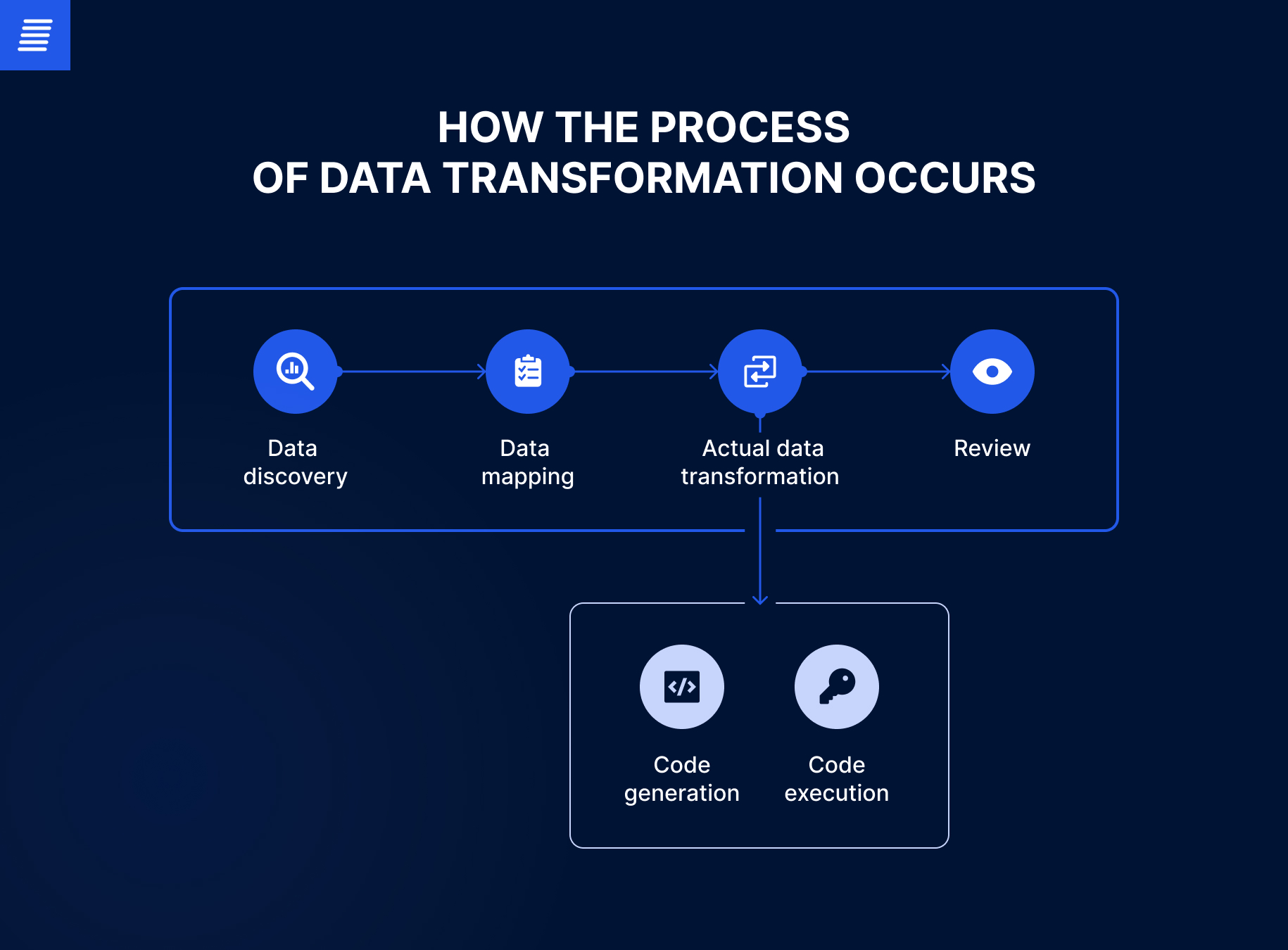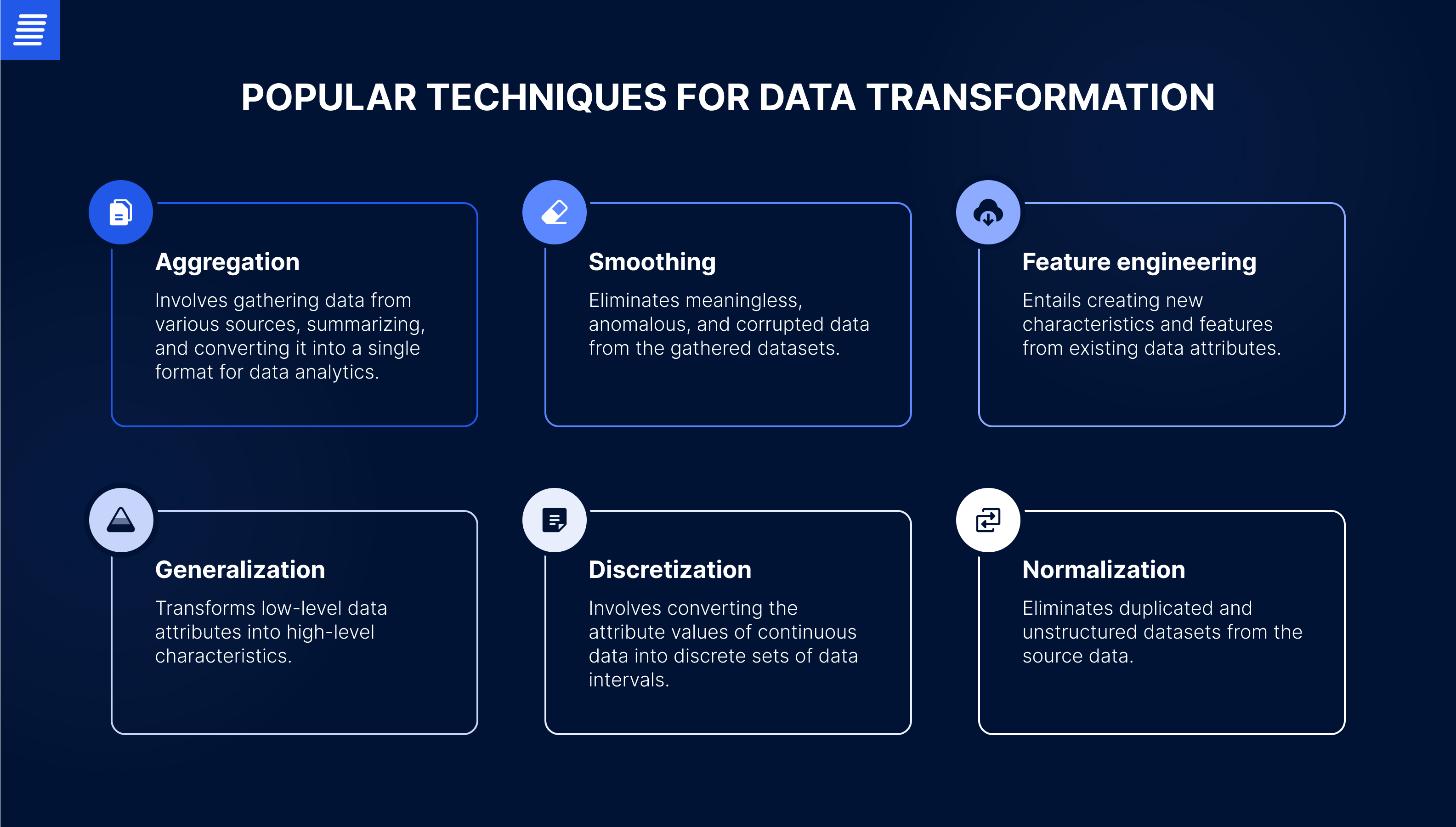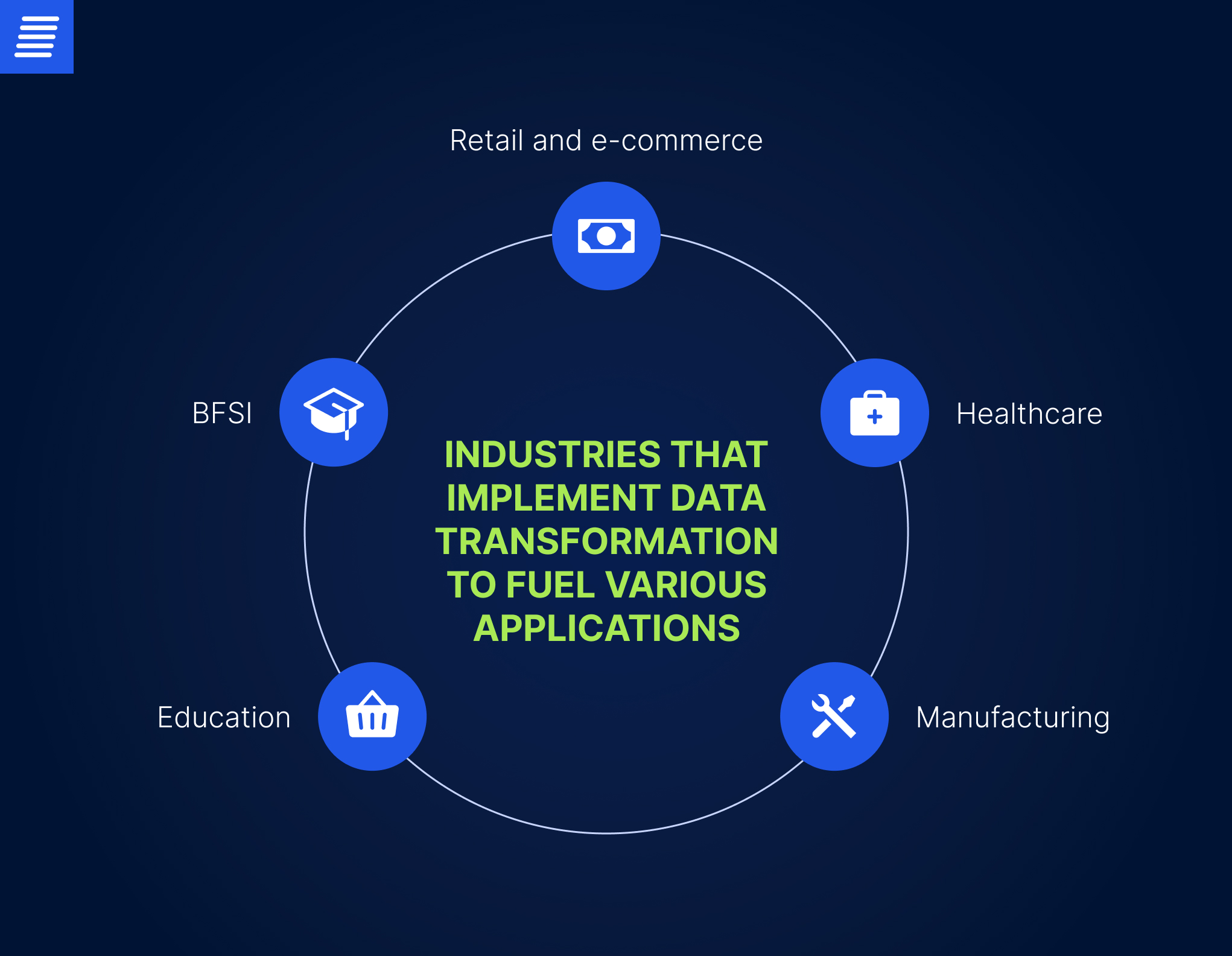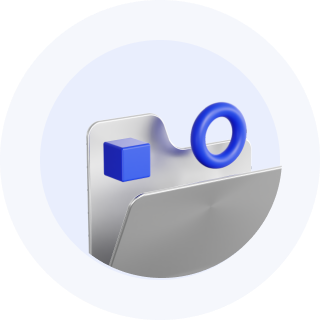
Contact us
Our team would love to hear from you.

According to a report by Exploding Topics.com, nearly 92% of companies brought practical value to their operations by investing in big data initiatives in 2023. With petabytes, or even zettabytes of data arriving in different formats from various sources, not all of it can be used for business intelligence (BI), data science, and data analytics purposes. One effective way to curate meaningful datasets and make them usable across diverse systems and applications is through the data transformation process. In this guide, we will delve into the concept of data transformation, covering its various types, key steps, techniques, and tools. We will also highlight the benefits and challenges of data transformation as well as its practical use cases.

Data transformation is the conversion of raw data from one format, structure, or representation into a clean, validated, and usable form. This critical process takes place during the ETL (extract, transform, load) and ELT (extract, load, transform) processes, employing a wide range of data transformation methods. These methods address data inaccuracies, eliminate redundant and unnecessary datasets, and enhance the quality of the collected data. They also prepare data for further processing, analytics, reporting, and visualization. Businesses invest in data transformation to ensure data accuracy, consistency, and usability. This facilitates the extraction of valuable insights, enables the precise predictions of future outcomes and trends, and guides strategic planning.
Data transformation is a complex and multifaceted process. If implemented properly, it can ensure the robustness of key data aspects, such as relevance, integrity, accessibility, security, and more. Depending on their business goals and needs, firms can implement the following types of data transformation:
Focuses on enhancing datasets to optimize data usability for further analytics and other data-related tasks.
Involves cleaning, altering, and simplifying data in addition to removing redundancies to improve data quality.
Used to modify data to meet specific parameters and requirements, presenting data in a visually appealing and discernible form for end users.
Aims to combine, split, change, or reorganize data characteristics, topology, and geometry, as well as create new data structures.
Numerous companies store their data in a cloud-based data warehouse or data lake rather than utilizing traditional on-premises storage. This indicates that they execute data transformation in the cloud ETL or ELT, with slight variations between these two pipelines. During ETL, data is consolidated from various sources and transformed into a structured format, after which it is loaded into a data warehouse for further applications. In the ELT data pipeline, raw data is extracted from disparate sources, loaded into a data lake for storage, and undergoes dynamic changes only during data analytics or upon request.
Regardless of whether the ETL or ELT approach is selected, the key steps involved in data transformation remain consistent, with the only distinction being the sequence of transformation. However, the transformation process can vary significantly depending on exact business needs and objectives, as well as the nature, volumes, and complexity of the gathered data. Following are the fundamental data transformation steps.
The initial step in data transformation involves discovering and interpreting the original data format. At this stage, data engineers leverage various data profiling tools and techniques to deeper understand the structure and features of raw data and determine how to transform it into the required format.
The mapping phase includes creating a data transformation plan. It specifies relationships between the source and data components and identifies how specific data fields will be matched, modified, and aggregated. The plan also outlines which data must be transformed into the target format, how it will be structured, and the type of transformation required.
At this stage, raw data—which can be structured (databases) and unstructured (documents, media content, external APIs, etc.)—is transferred from the source for further transformation, which takes place either after data extraction (ETL) or loading (ELT).
Once the raw data has been extracted or extracted and loaded into a storage system, it must be converted into a format suitable for BI and data analytics processes. This is the stage where the actual data transformation occurs, encompassing two important steps:
In the review phase, data experts assess the transformed data to ensure its alignment with the defined objectives and quality standards. This step also involves making the necessary adjustments, resolving glitches, and eliminating anomalies for enhanced accuracy and consistency.

We made it possible to empower data-driven insights and advanced analytics for the client’s success.
The key steps within the data transformation pipeline would be hampered without the incorporation of a wide variety of techniques. It is worth noting that there are countless techniques for data transformation. The ultimate choice of which methods to use is dictated by specific data characteristics and the end goals pursued by businesses. The most essential methods are described below.
Data aggregation focuses on gathering various data points from multiple sources, as well as summarizing and converting them into a single, manageable format. This format is suitable for analytics, reporting, and visualization, providing a high-level overview of data, facilitating the retrieval of insights, and enhancing decision-making.
Data smoothing involves removing meaningless, anomalous, and corrupted data from the collected datasets. Employing this method results in the elimination of all outliers, enhancing the data analytics process and contributing to the discovery of patterns and trends.
Feature engineering entails creating new characteristics and features from existing data attributes. It expedites the data mining process, focusing on identifying patterns in extensive datasets using machine learning (ML) algorithms and statistical methods.
Based on the concept of hierarchy, generalization transforms low-level data attributes into high-level characteristics. This method ultimately enables a broader categorization of data, leading to a comprehensive overview of insights and trends.
This data transformation technique involves converting the attribute values of continuous data into discrete sets of data intervals. Leveraging discretization empowers a deeper study and analysis of information, increasing the overall efficiency of data processing.
To eliminate duplicated and unstructured datasets from the source data, specialists leverage normalization. This technique helps organize and structure data in a standard format. It also ensures data consistency and integrity, improving the efficiency of ML algorithms and statistical analysis.

With a growing number of businesses emerging every day, it’s becoming increasingly challenging for enterprises of all sizes to stay ahead of the competition and thrive. One way for organizations to address this challenge is by integrating generative artificial intelligence (AI) into their business operations.
To streamline data transformation techniques and address the complexities associated with handling disparate datasets, it is essential to leverage data transformation tools. Instruments for modifying raw data into valuable information can be broadly categorized into the following types.
Distributed by commercial organizations, enterprise-level instruments are tailored for businesses that lack the resources or time to build in-house, proprietary solutions. Featuring dynamic interfaces, predefined data pipelines, and a plethora of advanced features, such tools excel in data integration, transformation, and processing. They also offer high levels of scalability, efficiently managing ever-growing datasets and streamlining workflows. Examples of potent enterprise tools for data transformation include IBM InfoSphere DataStage, SAP Data Services, the commercial version of Talend, and more.
Organizations can capitalize on open-source data transformation instruments if their data engineers are proficient in building, managing, and maintaining data pipeline processes. Open-source tools empower businesses to accurately tailor their data transformation workflows according to their specific needs, all while minimizing license-related costs. Talend Open Studio, Apache NiFi, and CloverDX are several powerful open-source data transformation tools. These tools provide companies with the necessary levels of flexibility, adaptability, and transparency while improving cost-effectiveness.
With the growing popularity of data transformation in the cloud, businesses are increasingly adopting cloud-based instruments for the process. Hosted in cloud settings, these tools provide unparalleled levels of scalability, elasticity, and low latency. By leveraging them, organizations can accommodate continuously growing volumes of data, scale the transformation process based on exact needs, and adapt to evolving market and business requirements. AWS Glue, Azure Data Factory, and Data Build Tool (dbt) are among the most popular cloud-based tools used by organizations to execute data transformation.
A multitude of organizations prioritize the development of bespoke tools rather than tapping into off-the-shelf solutions. By adhering to this approach, companies can create instruments aligned with their unique requirements and easily integrate them with existing systems and infrastructures. Building custom tools for data transformation requires expertise in Java, Python, R, SQL, and more.
| Types | Purpose | Benefits | Examples |
|---|---|---|---|
| Enterprise-level tools | Cater to businesses, lacking resources or time to build in-house, proprietary solutions. | High levels of scalability, ability to manage ever-growing datasets, streamlined workflows. | IBM InfoSphere DataStage, SAP Data Services, the commercial version of Talend. |
| Open-source tools | Suitable for companies whose data engineers are proficient in building, managing, and maintaining data pipeline processes. | Minimize license-related costs. | Talend Open Studio, Apache NiFi, CloverDX. |
| Cloud-based tools | Used to accommodate continuously growing volumes of data and scale the transformation process based on exact needs. | Unparalleled levels of scalability, elasticity, and low latency. | AWS Glue, Azure Data Factory, Data Build Tool (dbt). |
| Custom tools | A good option for companies that prioritize building bespoke instruments. | Align with unique requirements, integrate with existing systems and infrastructures. | Require knowledge of Java, Python, R, SQL, and more. |
Data transformation plays a pivotal role in converting raw data into tangible value. Here’s exactly how businesses across various sectors can benefit from implementing this process.
One of the main perks surrounding data transformation is the improvement of data quality. Data transformation enhances the accuracy, reliability, and integrity of information by eliminating errors, inconsistencies, and duplicates, as well as adding missing data values. This minimizes the possibility of quality issues and misinterpretations during analytics. Additionally, high-quality data paves the way for extracting deeper insights and making business-critical decisions with confidence.
Data transformation is a vital step in enhancing the compatibility of data with various platforms, applications, and existing data formats. Due to increased compatibility, businesses can exchange and utilize data among different systems, departments, and users. This leads to a more interconnected ecosystem, with optimized workflows, smoother business operations, and improved efficiency.
The transformation process produces data with a clear and well-defined structure. This structure facilitates multiple aspects of data organization, management, and processing. Converting data into a unified format and storing it in a data warehouse or data lake ensures increased accessibility for various systems and users. Modified data also optimizes query speed and execution time, unlocking the potential for deeper analytics and meaningful insights.
Forward-thinking companies embrace data transformation as an efficient way to gain a more profound understanding of customer preferences, expectations, and behavior. This understanding empowers businesses to anticipate customer demands, improve products and services, and provide personalized offerings. Consequently, firms deliver frictionless and engaging customer experiences, propelling customer relationships to new heights.
A centralized data warehouse and Microsoft Power BI allow collecting and analyzing data from the divisions scattered across the USA.
Data transformation plays an extremely important role in data processing, ensuring that information is ready for real-time applications and tasks. Despite its importance, it presents several key challenges that companies need to confront.
Transforming data into a suitable format is a complicated process. It requires a substantial investment in essential software, hardware, computing resources, and licensed transformation tools. Beyond these expenses, businesses must allocate considerable financial resources to either upskill existing personnel or hire experienced data scientists who know how to implement a successful data transformation process.
Given that data transformation involves handling sensitive business and personal information, protecting it from unauthorized access and potential threats poses a grave challenge. To safeguard data during transformation, it is imperative to adhere to all applicable security regulations and privacy laws. Incorporating robust security measures, including data encryption, access control, monitoring, and more, is critical in maintaining data integrity and confidentiality throughout the transformation journey.
Handling extensive volumes of data is a resource-intensive and time-consuming task, exerting a negative impact on the speed and performance of data transformation pipelines. To address this challenge, it is recommended that organizations opt for cloud-based computing resources and storage. This allows them to capitalize on the scalability, flexibility, and agility of cloud infrastructure and optimize data transformation pipelines, achieving improved speed and performance.
Constantly evolving market changes, customer demands, and stringent competition prompt cross-industry businesses to modify their data for a wide range of application scenarios.

Healthcare organizations leverage data transformation techniques to integrate and structure patient, clinical, and medical research data, preparing it for advanced analytics. Based on analytics results, healthcare providers can improve patient care, enhance diagnostic accuracy, and facilitate disease control and prevention, among other critical tasks.
In the retail and e-commerce industry, data transformation is necessary to clean, aggregate, and summarize vast amounts of customer and product data. Once analyzed, this information is used to complete numerous tasks, including building personalized marketing strategies, forecasting customer demands, managing inventory, and more.
Manufacturing companies modify data from production lines, supply chains, and customer feedback to optimize manufacturing processes, ensure efficient supply chain management, and improve product quality. Other manufacturing tasks driven by data transformation include predictive maintenance, demand forecasting, and real-time monitoring of production processes.
Banking, financial services, and insurance (BFSI) organizations utilize the transformed transaction, market, and customer data for a multitude of tasks. These tasks include identifying fraudulent activities, assessing credit risks, supporting regulatory compliance and reporting, and tailoring financial products according to specific customer needs.
Finally, educational institutions capitalize on data transformation to refine their teaching methods, guide educational research, predict learning outcomes, and foster student engagement.
In today’s highly dynamic and fiercely competitive market, data is a powerful and reliable instrument that businesses can arm themselves with to prosper and thrive. However, for data to add value to a company’s operations, it must be converted into the appropriate format. This is where data transformation, along with its key steps, techniques, and tools, has proved its efficacy. While the advantages of data transformation are infinite, its challenges can be easily overcome, and we possess the knowledge to do so. If your business generates extremely large volumes of data and requires a robust data transformation strategy, our skilled data engineers will be glad to assist. Contact us now, and we will transform your data into actionable insights that maximize outcomes and drive your business forward.

Data transformation is the process of converting raw data from one format, structure, or representation into a clean, validated, and usable form.
Depending on their business demands, organizations can conduct constructive, destructive, aesthetic, and structural data transformation.
The key steps involved in the data transformation process occur within ETL and ELT workflows, encompassing discovery, mapping, execution, actual modification with code generation and execution, and review.
Essential data transformation techniques used by data engineers include but are not limited to aggregation, smoothing, feature engineering, generalization, discretization, and normalization.
Based on their goals, companies can use enterprise-level, open-source, cloud-based, and custom data transformation instruments.
The benefits of converting data into a usable format include improved data quality; enhanced compatibility; efficient data organization, management, and processing; and refined customer experiences.
Costly implementation, security concerns, and performance constraints are the key challenges surrounding data transformation.
Numerous industries, including healthcare, e-commerce, manufacturing, BFSI, and education, can capitalize on data transformation.
Real-life examples of data transformation include improving patient care, developing personalized marketing strategies, optimizing manufacturing processes, identifying fraudulent activities, and guiding education research.
Can’t find the answer you are looking for?
Contact us and we will get in touch with you shortly.
Our team would love to hear from you.
Fill out the form, and we’ve got you covered.
What happens next?
San Diego, California
4445 Eastgate Mall, Suite 200
92121, 1-800-288-9659
San Francisco, California
50 California St #1500
94111, 1-800-288-9659
Pittsburgh, Pennsylvania
One Oxford Centre, 500 Grant St Suite 2900
15219, 1-800-288-9659
Durham, North Carolina
RTP Meridian, 2530 Meridian Pkwy Suite 300
27713, 1-800-288-9659
San Jose, Costa Rica
Escazú Corporate Centre, Piso 6
40602, 1-800-288-9659